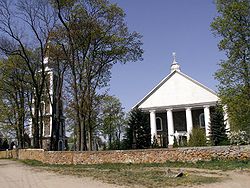Eišiškės
| Eišiškės | ||
|---|---|---|
| City | ||

Church
|
||
|
||
| Location of Eišiškės | ||
| Coordinates: 54°10′N 25°00′E / 54.167°N 25.000°ECoordinates: 54°10′N 25°00′E / 54.167°N 25.000°E | ||
| Country |
|
|
| Ethnographic region | Dzūkija | |
| County | Vilnius County | |
| Municipality | Šalčininkai district municipality | |
| Eldership | Eišiškės eldership | |
| Capital of | Eišiškės eldership | |
| First mentioned | 1384 | |
| Granted city rights | 1950 | |
| Population (2011) | ||
| • Total | 3,416 | |
| Time zone | EET (UTC+2) | |
| • Summer (DST) | EEST (UTC+3) | |
Eišiškės (![]() pronunciation , Polish: Ejszyszki, Russian: Эйши́шки/Eishishki, Belarusian: Эйшы́шкі/Eishyshki, Yiddish: אײשישאׇק/Eyshishok) is a city in southeastern Lithuania on the border with Belarus. It is situated on a small group of hills, surrounded by marshy valley of Verseka and Dumblė Rivers. Rivers divide the town into two parts; the northern part is called Jurzdika. As of 2011, Eišiškės had a population of 3416. It has a small hospital and two high schools (one for Polish and another for Lithuanian students).
pronunciation , Polish: Ejszyszki, Russian: Эйши́шки/Eishishki, Belarusian: Эйшы́шкі/Eishyshki, Yiddish: אײשישאׇק/Eyshishok) is a city in southeastern Lithuania on the border with Belarus. It is situated on a small group of hills, surrounded by marshy valley of Verseka and Dumblė Rivers. Rivers divide the town into two parts; the northern part is called Jurzdika. As of 2011, Eišiškės had a population of 3416. It has a small hospital and two high schools (one for Polish and another for Lithuanian students).
According to the Lithuanian Chronicles, the town was named after Eikšys, possibly one of the sons of Karijotas.
According to Yaffa Eliach, "Local Jewish folklore had its own account of how the name of the town came into being: Once upon a time in the early days of the shtetl, a man came home and was greeted by his wife with a special treat of freshly cooked varenie (preserves), made from the berries that grow in such abundance in the region. Not realizing they were still sizzling hot, he took a big bite and scorched his tongue, which caused him to yell "Heishe-shok!" (Hot sauce!) at the top of his lungs."
Eišiškės is mentioned for the first time in the Treaty of Königsberg (1384) between Vytautas the Great and the Teutonic Knights. East of the town there is a castle site, dating back from the 14th–15th centuries. Historian Ignas Jonynas argued that Anna, Grand Duchess of Lithuania and wife of Vytautas the Great was a sister of Sudimantas, a nobleman from Eišiškės and commander of Vytautas' army. An important route, connecting Vilnius, Hrodna, and Warsaw, ran through the town. Protected by the castle and boasting a church built by Vytautas, the town became one of the important trading centers in the Grand Duchy of Lithuania. It had a court and here nobles gathered for a sejmik.
...
Wikipedia


